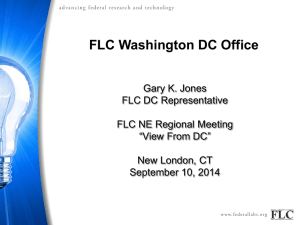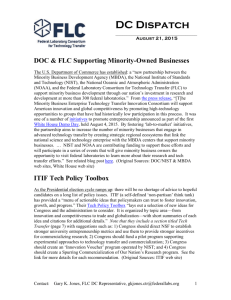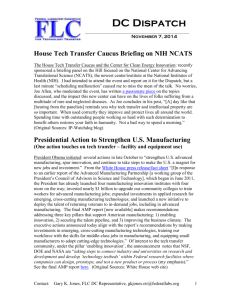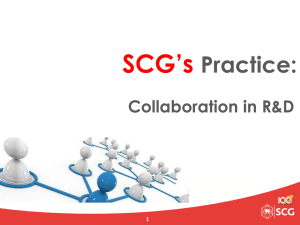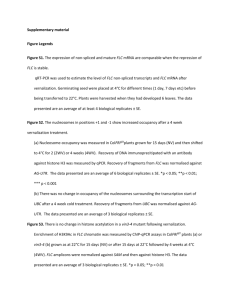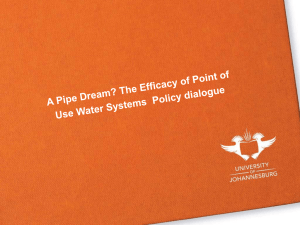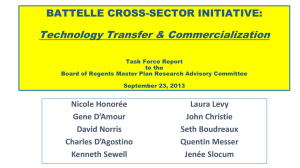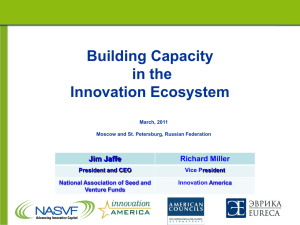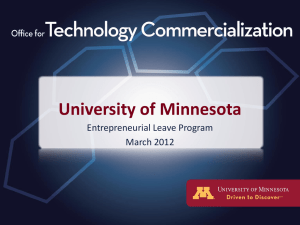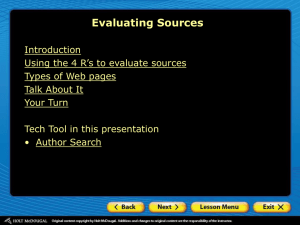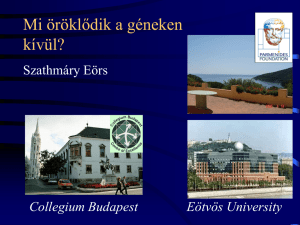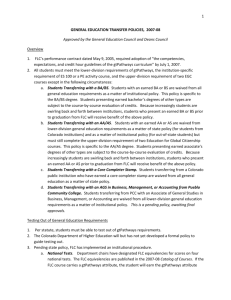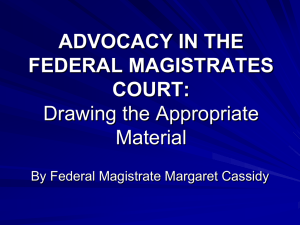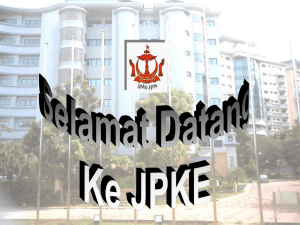White House`s Lab-to-Market Effort/Initiative Speaker(s): Gary Jones
advertisement
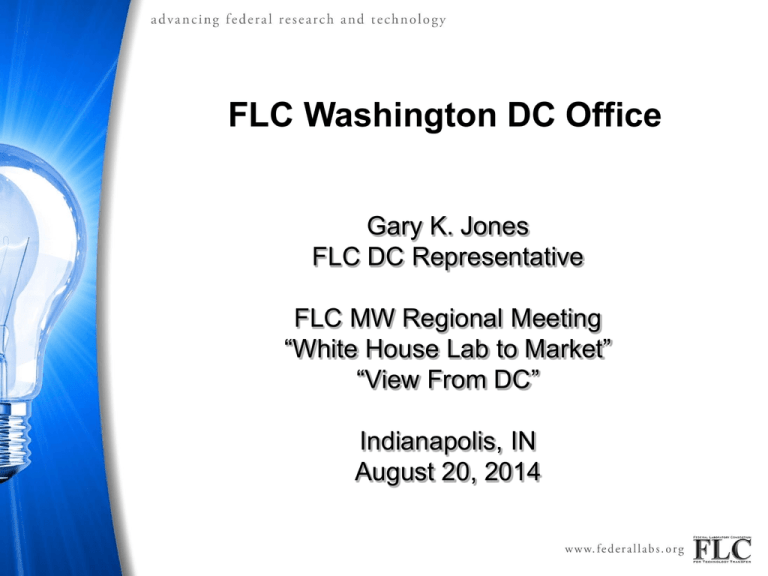
FLC Washington DC Office Gary K. Jones FLC DC Representative FLC MW Regional Meeting “White House Lab to Market” “View From DC” Indianapolis, IN August 20, 2014 Overview Administration Actions White House Lab to Market Miscellaneous Initiatives R&D Budget (2015 & 2016) Congressional & Judicial Actions General DOE-focused Alice v. CLS Bank FLC Initiatives FLC Bus, AT, Virtual Mtg Presidential Memorandum Update Accelerating Technology Transfer and Commercialization of Federal Research in Support of High-Growth Businesses (Oct 2011) Establishing Goals and Measuring Progress Streamline Tech Transfer and Commercialization Process Enhance Local and Regional Partnerships Status (see all 13 reports here) (NIST web site) Executive Summary of Agency Reports Opportunities to Substantially Increase Technology Transfer - identifies opportunities and consolidates recommendations from the IAWGTT for innovative approaches to T2 proposed by agencies in their plans. Revised Technology Transfer Metrics - outlines proposed changes to the set of T2 metrics that are reported annually by the Department of Commerce, in conjunction with the IAWGTT, in the Federal Laboratory Technology Transfer Summary Report to the President and the Congress. L2M: Overview (From L2M Summit to CAP Goals) ■ Lab-To-Market Summit (May 2013) ■ Lab-To-Market Initiative (May 2013 - Present and ongoing) “To significantly accelerate and improve technology transfer by streamlining administrative processes, facilitating partnerships with industry, evaluating impact, and opening Federal R&D assets as a platform for innovation and economic growth” (L2M CAP Vision) ■ White House Cross Agency Priority Goals (President’s Management Agenda) - CAP Goal #7: Lab to Market L2M: Action Plan (From Vision to CAP Goal Action Plan) “This action plan is a flexible framework, calling on agencies to tailor and prioritize Lab-to-Market activities specific to their missions, capabilities, and authorities.” (See performance.gov and L2M Action Plan and Status) L2M CAP Action Plan Overview: ■ Developing Human Capital ■ Empowering Effective Collaborations ■ Opening R&D Assets ■ Fueling Small Business Innovations ■ Evaluating Impact L2M AP: Developing Human Capital ■ Expand number of individuals with private-sector experience working in tech transfer within research agencies ■ Establish guidance and policies that enable federal researchers to work outside government for limited periods ■ Provide opportunities for widespread experiential entrepreneurship education ▪ Working with Office of Government Ethics (OGE) to obtain clear guidelines for waivers for entrepreneurial activities ▪ New regulations under 15 USC 3712 (personnel exchange) will help broadly implement successes ▪ Expanding I-Corps program ▪ Agencies are identifying programs to launch or expand L2M AP: Empower Effective Collaborations ■ Increase priority level of R&D commercialization activities and outcomes at federal labs ■ Optimize T2 authorities and best practices across labs ■ Fully utilize existing authority for research agencies to co-fund projects between agencies and leverage charitable gifts to advance R&D commercialization ▪ Expect recommendations on: • Best language, management plans, etc. for GOGO and GOCO labs • Most effective mechanisms, uses of collaborations and gifts • Barriers to joint project funding across agencies ▪ Addressing working on getting micro-entity or small entity status for federal labs to avoid conferring large entity rqts on partners L2M AP: Open R&D Assets ■ Agencies are to make comprehensive IP and R&D facility data sets available in open and machine-readable format on www.data.gov ■ Increase utilization of facilities and equipment by external entrepreneurs and innovators ■ Reduce cost/complexity of executing licenses ▪ FLC launched its Available Technologies search – expanding ▪ Next up: FLCBusiness, a tool for businesses to find facilities ,etc. ▪ Making recommendations for IP licensing programs that support easier access by startups and small businesses, and for R&D facility and equipment use policies. L2M AP: Fueling Small Business Innovation ■ SBIR managers are: • Launching a unified and comprehensive Federal search tool across all open SBIR/STTR solicitations • Analyzing lead times, best practices, accounting procedures across agencies • Creating an interagency playbook for commercialization best practices ■ Each agency is to implement plans to: • Reduce lead times • Align more solicitation topics with cross-agency R&D priorities • Streamline accounting and reporting requirements and allow flexibility for small businesses to adapt their performance benchmarks based on new commercialization pathways discovered during the performance period L2M AP: Evaluating Impact ■ Report on metrics that capture R&D commercialization inputs and outputs ■ Develop outcome metrics that capture longer-term economic impact, in collaboration with the research community ▪ Look at technical areas in patents, b/o CRADAs and licenses by small business v. large business, etc. ▪ Maybe measure start-ups ▪ Develop studies on higher order research questions ▪ Cite other peer reviewed studies, etc. ▪ Other Other Administration Initiatives (With FLC Engagement) Patents for Humanity is an awards competition for aiding the less fortunate, by rewarding the use of patented technologies to solve global challenges WIPO-Green is an interactive marketplace that promotes innovation and diffusion of green technologies by connecting technology and service providers with those seeking innovative solutions. Accelerating green technology transfer to impact American lives highlights the FLC Available Technologies search tool (and many examples of ‘green’ tech transfer). (White House blog post; Paul Zielinski, FLC Chair, co-author) Federal R&D Budget (FY 2015 Proposed) OSTP FY 2015 S&T Budget Documents FY 2014 Budget proposes $135.4 billion for Federal R&D, an increase of $1.7 billion or 1.2 percent over the 2014 enacted* Federal research portfolio—comprising basic and applied research—would total $64.7 billion, up $251 million or 0.4 percent Non-defense R&D would rise 0.7 percent ($477 million) to $65.9 billion; Defense (DOD & DOE) R&D would rise 1.7 percent ($1.2 billion) to $69.5 billion Increases: DOE (8.4%), USGS (5.5%), NOAA (4.1%), NIST (3.4%), DOT (1.4%), USDA (1.2%), DOD (0.9%), NIH (0.7%) Decreases: NASA (-1.0%), DHS (-15.1%) Flat: NSF, EPA Status: House 6 of 12 Passed House (late July) Senate: None passed Senate * Comparison are all to FY 2014 enacted Source: AAAS Federal R&D Budget (FY 2015 Proposed) “[Speaker] Boehner told reporters that the House will pass a short-term continuing resolution to keep the government open sometime in September, avoiding a government shutdown that would otherwise occur on the last day of the month. The legislation would likely expire in early December, he said, punting decisions about the nation's spending to a lame-duck Congress just after the midterm election.” National Journal Daily, 7/25/14 Federal R&D Budget (OMB 2016 S&T Budget Guidance) FY 2016 S&T Budget Priorities (July 18) “The priorities covered in this memo require investments in R&D; support for activities, such as [STEM] education, technology transfer, R&D facilities, and scientific data collection and management, that enable a robust science and technology enterprise; and cooperation among multiple Federal agencies.” Multi-agency Priorities: Advanced manufacturing Clean energy Earth observations Global Climate Change IT and high-perf computing National and homeland security R&D for informed policy-making Federal R&D Budget (OMB Management Agenda: CAP Goals and 2016 Budget) Management Agenda Priorities for FY 2016 Budget (July 18) “The President's Management Agenda seeks to improve the way that Government works and delivers for citizens. It is guided by four pillars: efficiency, effectiveness, economic growth, and people and culture. The Management Agenda is being executed through eight distinct Management Cross-Agency-Priority Goals that fall under these four pillars. …. For each selected goal, we have identified targeted areas for additional information that agencies should address in their budget submissions.” CAP#7: Economic Growth - Lab to Market: “Increase the economic impact of Federally-funded research and development by accelerating and improving the transfer of new technologies from the laboratory to the commercial marketplace” . Congressional Actions (113th Congress) Multiple proposals potentially affecting tech transfer activities (related to STTR and tech commercialization, DOE tech transfer, use of prize competitions, tech commercialization pilot program at NSF, other). Title Number Date Status DOE Mod Act HR 5120 7/14 Passed House (to S.) EINSTEIN Act HR 4869 6/14 Ref. House SST ATTAIN Act S 2129 3/14 Ref. Senate ENR INNOVATES Act S 1973 1/14 Ref. Senate ENR TRANSFER Act HR 2981 8/13 (amended) Ref. House SST&SB CRADA Act HR 1711 4/13 Ref. House SST Congressional Actions (DOE-centric proposals) Common Components (partly derived from ITIF Turning the Page report (2013): Reorganization (creating new UnderSec for Science and Energy or creating new Office of Advanced Research, Tech Transfer, and Innovation in Energy OARTTIE) with tech transfer responsibilities; Est. commission to review T2 program and make recommendations; Carry out an Agreements for Commercializing Technology (ACT) pilot based on program developed in 2011 Delegate signature authority to lab directors for agreements under $1M. Allow lab directors to use funds for early-stage and pre-commercial demonstration activities to demonstrate commercial potential of technologies Allow DOE-funded researchers to participate in I-Corp (NSF) or establish a DOE T2-Corps (modeled on I-Corps) Other Congressional Actions (TRANSFER Act of 2013) Technology and Research Accelerating National Security and Future Economic Resiliency (TRANSFER) Act of 2013 (H. 2981) “‘Each Federal agency required … to establish an STTR program shall carry out a grant program to support innovative approaches to technology transfer at institutions of higher education, non-profit research institutions and Federal Laboratories in order to accelerate the commercialization of federally funded research and technology by small business concerns, including new businesses.” Use of Funds: early-stage proof of concept funding, identifying research and technologies for commercialization, tech maturation funding, tech validation, market research, clarifying IP rights, mentoring and education Amounts: $1M to institution ($150K from institution to individual) Introduced: Amended: 8/2/13; House SB Cmte and House SS&T Cmte. 12/5/13 House SST Strongly supported by the university community Judicial Actions (Software patentability) Alice Corporation v. CLS Bank International June 19th (SC Decision) “The question presented is whether these claims are patent eligible under 35 U. S. C. §101, or are instead drawn to a patent-ineligible abstract idea. We hold that the claims at issue are drawn to the abstract idea of intermediated settlement, and that merely requiring generic computer implementation fails to transform that abstract idea into a patent-eligible invention.” June 19th (IPWatchdog blog) “On first read I don’t see how any software patent claims written as method or systems claims can survive challenge.” June 25th (USPTO Guidance issued) Preliminary Examination Instructions in View of the SC Decision in Alice Corp. v. CLS Bank International July 25th (Patently-O blog) “Based on info from several sources, it appears that the USPTO is now taking a more aggressive stance on subject matter eligibility … It appears that applications whose inventive features are found in software or information processing will now have a difficult time being patented.” Judicial Actions (Software patentability - continued) Alice Corporation v. CLS Bank International August 5th (Peggy Focarino, USPTO Commissioner for Patents) “[T]the USPTO has applications that were indicated as allowable prior to Alice Corp., but that have not yet issued as patents. Given our duty to issue patents in compliance with existing case law, we have taken steps to avoid granting patents on those applications containing patent ineligible claims in view of Alice Corp. To this end, our primary examiners and supervisory patent examiners (SPEs) promptly reviewed the small group of such applications that were most likely to be affected by the Alice Corp. ruling.” “We withdrew notice of allowances for some of these applications due to the presence of at least one claim having an abstract idea and no more than a generic computer to perform generic computer functions. After withdrawal, the applications were returned to the originally assigned examiner for further prosecution. Over the past several days, our examiners have proactively notified those applicants whose applications were withdrawn. …..” Resources on FLC Web Site (www.federallabs.org) Points of Contact (Agency TTOs, >300 Lab TTOs) Locate Technologies and Capabilities (Tech Locator Service, Available Technologies Search, FLC Business Resource (coming soon)) Training and Education (Courses, Materials, etc.) Reference Materials (Green Book, Desk Reference, Mechanisms Database, etc.) News & General Information Youtube demo for FLC Available Technologies Search Tool Lab Reps Contact: Denise Wainer dwainer@utrs.com April 28 – 30, 2015 FLC Washington DC Representative Gary Jones Phone: 240-444-1383 gkjones.ctr@federallabs.org www.federallabs.org
